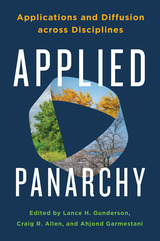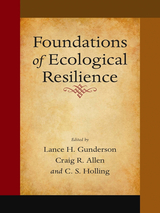2 books about Allen, Craig Reece

Applied Panarchy
Applications and Diffusion across Disciplines
Edited by Lance H. Gunderson, Craig R. Allen, and Ahjond Garmestani
Island Press, 2022
After a decades-long economic slump, the city of Flint, Michigan, struggled to address chronic issues of toxic water supply, malnutrition, and food security gaps among its residents. A community-engaged research project proposed a resilience assessment that would use panarchy theory to move the city toward a more sustainable food system. Flint is one of many examples that demonstrates how panarchy theory is being applied to understand and influence change in complex human-natural systems. Applied Panarchy, the much-anticipated successor to Lance Gunderson and C.S. Holling’s seminal 2002 volume Panarchy, documents the extraordinary advances in interdisciplinary panarchy scholarship and applications over the past two decades. Panarchy theory has been applied to a broad range of fields, from economics to law to urban planning, changing the practice of environmental stewardship for the better in measurable, tangible ways.
Panarchy describes the way systems—whether forests, electrical grids, agriculture, coastal surges, public health, or human economies and governance—are part of even larger systems that interact in unpredictable ways. Although humans desire resiliency and stability in our lives to help us understand the world and survive, nothing in nature is permanently stable. How can society anticipate and adjust to the changes we see around us? Where Panarchy proposed a framework to understand how these transformational cycles work and how we might influence them, Applied Panarchy takes the scholarship to the next level, demonstrating how these concepts have been modified and refined. The book shows how panarchy theory intersects with other disciplines, and how it directly influences natural resources management and environmental stewardship.
Intended as a text for graduate courses in environmental sciences and related fields, Applied Panarchy picks up where Panarchy left off, inspiring new generations of scholars, researchers, and professionals to put its ideas to work in practical ways.
Panarchy describes the way systems—whether forests, electrical grids, agriculture, coastal surges, public health, or human economies and governance—are part of even larger systems that interact in unpredictable ways. Although humans desire resiliency and stability in our lives to help us understand the world and survive, nothing in nature is permanently stable. How can society anticipate and adjust to the changes we see around us? Where Panarchy proposed a framework to understand how these transformational cycles work and how we might influence them, Applied Panarchy takes the scholarship to the next level, demonstrating how these concepts have been modified and refined. The book shows how panarchy theory intersects with other disciplines, and how it directly influences natural resources management and environmental stewardship.
Intended as a text for graduate courses in environmental sciences and related fields, Applied Panarchy picks up where Panarchy left off, inspiring new generations of scholars, researchers, and professionals to put its ideas to work in practical ways.
[more]

Foundations of Ecological Resilience
Edited by Lance Gunderson, Craig R. Allen, and C.S. Holling
Island Press, 2009
Ecological resilience provides a theoretical foundation for understanding how complex systems adapt to and recover from localized disturbances like hurricanes, fires, pest outbreaks, and floods, as well as large-scale perturbations such as climate change. Ecologists have developed resilience theory over the past three decades in an effort to explain surprising and nonlinear dynamics of complex adaptive systems. Resilience theory is especially important to environmental scientists for its role in underpinning
adaptive management approaches to ecosystem and resource management.
adaptive management approaches to ecosystem and resource management.
Foundations of Ecological Resilience is a collection of the most important articles on the subject of ecological resilience—those writings that have defined and developed basic concepts in the field and help explain its importance and meaning for scientists and researchers.
The book’s three sections cover articles that have shaped or defined the concepts and theories of resilience, including key papers that broke new conceptual ground and contributed novel ideas to the field; examples that demonstrate ecological resilience in a range of ecosystems; and articles that present practical methods for understanding and managing nonlinear ecosystem dynamics.
Foundations of Ecological Resilience is an important contribution to our collective understanding of resilience and an invaluable resource for students and scholars in ecology, wildlife ecology, conservation biology, sustainability, environmental science, public policy, and related fields.
[more]
READERS
Browse our collection.
PUBLISHERS
See BiblioVault's publisher services.
STUDENT SERVICES
Files for college accessibility offices.
UChicago Accessibility Resources
home | accessibility | search | about | contact us
BiblioVault ® 2001 - 2024
The University of Chicago Press









